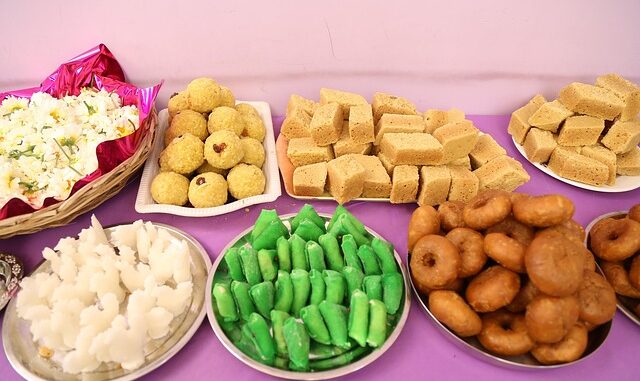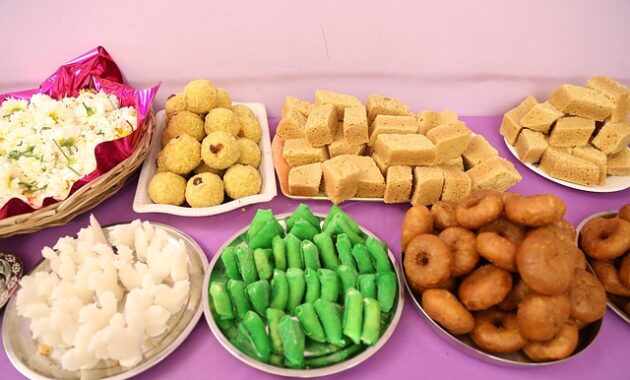
When we think of Mysore, our minds often drift toward its majestic palaces, rich history, and vibrant culture. Yet, tucked within the folds of this royal city is a world of delectable South Indian sweets that tell their own tale — a tale of heritage, flavor, and craftsmanship passed down through generations. Join us as we embark on a delicious journey to explore the irresistible sweets of Mysore and the surrounding South Indian region, each bite steeped in tradition and taste.
Mysore Pak – The King of Sweets

No tour of Mysore’s sweet legacy is complete without starting with its most iconic creation — Mysore Pak. Created in the royal kitchens of the Wodeyar dynasty, this sweet is a melt-in-the-mouth wonder made of gram flour, ghee, and sugar.
The original version, known as ‘Royal Mysore Pak’, is dense, soft, and dripping in pure ghee. Modern adaptations offer a firmer texture with a subtle crunch. Whether purchased from legendary establishments like Guru Sweets or Sri Krishna Sweets, Mysore Pak is a quintessential souvenir of this historic city.
Chiroti – A Delicate Delight
Chiroti, a crispy, layered pastry delicately dusted with powdered sugar or soaked in rich almond milk (badam milk), is another Mysorean marvel. This flaky dessert is made using refined flour, semolina, and ghee, then deep-fried to golden perfection.
Commonly prepared during weddings and festivals, Chiroti reflects the culinary finesse of Karnataka and is especially popular among locals during the festival of Deepavali (Diwali).
Kesari Bath – Fragrant and Flavorful
A breakfast staple turned dessert, Kesari Bath is a simple yet delightful dish made from semolina (rava), saffron, sugar, and ghee. Known for its rich aroma and vibrant yellow hue, it often includes cashews and raisins for added texture.
This dessert is often paired with Khara Bath (a spicy upma) in the famous combo called Chow Chow Bath, which showcases the perfect harmony of savory and sweet in South Indian cuisine.
Obbattu / Holige – Festive Sweet Flatbread
Known as Holige in Karnataka and Obbattu in other regions, this sweet flatbread is traditionally filled with jaggery and chana dal mixture. The dough is made from maida or wheat flour, flattened thinly, and roasted with a touch of ghee.
Obbattu is a festival favorite, especially during Ugadi (Kannada New Year), and variations include coconut, dry fruits, and even chocolate fillings in modern renditions.
Kunda of Belgaum – A Rich Caramel Treat
While not from Mysore city itself, Belgaum Kunda is a sweet delicacy of Karnataka that deserves a mention. Made by boiling and curdling milk with sugar and caramel, this sweet has a grainy texture and rich flavor that lingers on the palate.
Invented accidentally by Gajanan Mithaiwala, this dessert now holds a special place in the hearts of sweet lovers across Karnataka.
Payasam – South India’s Answer to Kheer
Known by many names — Payasam in Tamil and Malayalam, Payasa in Kannada — this is a liquid dessert made using rice, vermicelli, or moong dal, simmered in milk or coconut milk and sweetened with jaggery or sugar.
What sets Mysore’s version apart is the use of cardamom, saffron, and roasted dry fruits, often served warm in temples and homes during auspicious occasions like Dussehra and Navaratri.
Rava Ladoo – Soft, Spherical Sweetness
Rava Ladoo (or Sooji Ladoo) is a simple, humble sweet that packs a flavorful punch. Made using semolina, sugar, ghee, and cardamom, these laddoos are shaped into bite-sized balls and often enhanced with raisins and nuts.
They’re a Diwali favorite and a common homemade treat passed around during festivals and family gatherings, symbolizing sweet beginnings and blessings.
Coconut Barfi – Coastal Karnataka’s Gem
The influence of coastal Karnataka cuisine brings us the evergreen Coconut Barfi or Kobbari Mithai. This square-shaped treat is made with freshly grated coconut, jaggery or sugar, and cardamom, offering a chewy yet satisfying texture.
Some versions use condensed milk for richness, while others keep it traditional with a crunchy bite. Often wrapped in silver foil (varak), it is both a visual and gustatory delight.
Dharwad Peda – The Milky Marvel
Originating from Dharwad, this peda has become a legendary dessert across Karnataka. Made from khoa (reduced milk), sugar, and cardamom, the Dharwad Peda is slow-cooked to caramel perfection, giving it a deep brown color and rich flavor.
Though it began as a regional specialty, today it’s widely available in Mysore’s sweet shops, becoming a must-try for every visitor.
Ellu Bella – A Crunchy Festive Mix
While technically not a sweet in the conventional sense, Ellu Bella is a unique Sankranti tradition. It is a mix of white sesame seeds (ellu), jaggery pieces, dried coconut, peanuts, and roasted gram.
Shared among neighbors and family with the saying “Ellu bella thindu olle maathadi” (Eat this mix and speak only good), it promotes unity and sweet conversations, a fitting tribute to Karnataka’s warm hospitality.
Authentic Sweet Shops to Visit in Mysore
To experience the full spectrum of South Indian sweets, here are some iconic sweet shops in Mysore that continue to uphold traditional recipes:
- Guru Sweets, Sayyaji Rao Road – Famous for its rich Mysore Pak
- Bombay Tiffanys, Devaraj Urs Road – Offers a variety of traditional and modern sweets
- Mysore Pak & Sweets, near Devaraja Market – Ideal for freshly made regional treats
- Sri Krishna Sweets, multiple locations – Known for pure ghee-based South Indian delicacies
Conclusion: A Culinary Pilgrimage for the Sweet Tooth
The sweets of Mysore are more than just confections — they are edible embodiments of heritage, crafted with care, tradition, and an unmistakable love for flavor. From royal kitchen inventions like Mysore Pak to everyday delightslike Rava Ladoo and Kesari Bath, these sweets narrate the soul of Mysore’s culture.
Whether you’re a foodie, a traveler, or simply someone with a sweet tooth, this city invites you to indulge in its culinary treasures, one bite at a time.